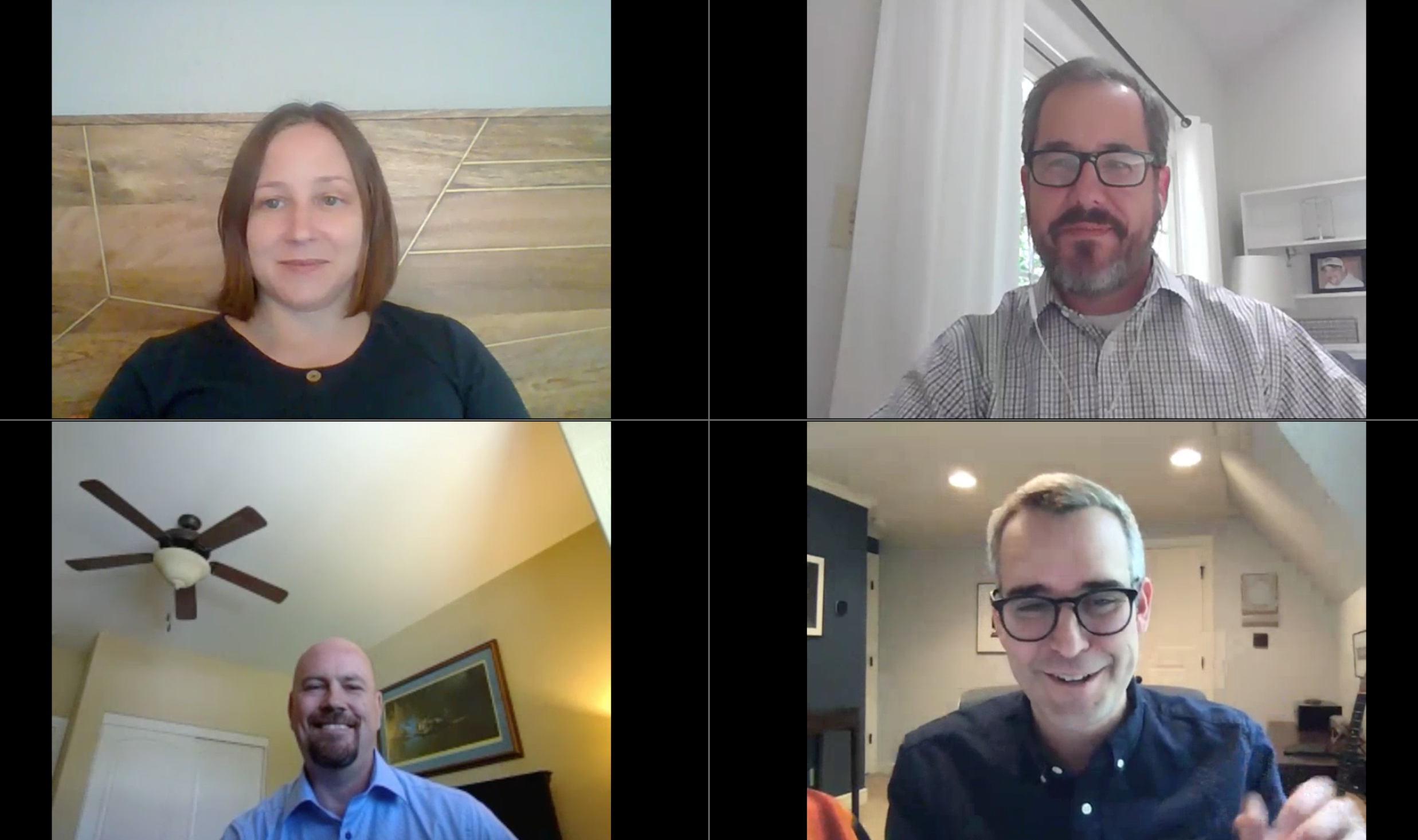5 Remote Work Takeaways for Local Government
"The business of government doesn't stop."
The City Manager of Williamsburg, VA often shares this line with his team of dedicated public servants. It rings true for them, and during the last few months of COVID-19, it rings true for everyone.
Local government is changing. Between responding to a global pandemic and continuing to deliver essential local services - city hall has taken over our living rooms. In the last couple of months, we focused efforts to speak with our partners on how they're responding to the pandemic and adjusting their work. Inspired by the experiences we've heard, we decided to share some of them in an open and candid format. Our Community of Practice is where the innovators and changemakers of local government come together for open dialogue on today's challenges.
To kick off our Community of Practice series, our CEO, Stephen Hardy, sat down with 3 leaders across different backgrounds of public service to share their experiences with 'City Hall in Your Living Room'.
 |
 |
 |
|
Mark Barham |
Kate Bender |
Jeff Lee Public Health Director Navajo County, AZ |
Across time zones, departments, roles and responsibilities - the perspectives of Mark Barham, Kate Bender, and Jeff Lee prove servants all over are dealing with similar challenges. We broadcasted the entire conversation as a webinar, open for anyone to access, and heard how helpful and validating the experience was for attendees. To amplify their experiences, we've wrapped up 5 key takeaways from the conversation, and made the entire recorded webinar available for you to access here.
Open it up and take a listen or read on to see how your experiences may relate.
1. The right plan doesn’t always exist, but we can still prepare.
Whether your department or community had plans in place or not - it’s fair to say a global health pandemic leaves room for some challenges. After all, COVID-19 quickly raised new concerns for us all while limiting us at the same time.
Still, the right plan is only as good as its planners. As our panelists reminded us: the learning curve is steep, but the tenacity of local government has risen to fill in the blanks.
“We had a disaster recovery plan in place”, Barham recalled. “We had a Continuity of Operations Plan. We didn't have the pandemic clause in there to understand how to respond when a pandemic hits.” While lacking specifics for a pandemic, Barham emphasized how crucial the technology infrastructure his city had put into place over the last five years. Cloud migration of email, phone, and similar systems made the transition to remote work a lot easier for Williamsburg, VA. Having this in place allowed Barham and his colleagues time to engage and listen to experts during the earlier stages of the pandemic so that when the work-from-home order was given, Williamsburg was able to make the transition within one day.
Across the country in Navajo County, AZ, Lee’s experience wasn’t too far off. “We have a pandemic plan. It probably has a foot of dust on it,” he said. Navajo County has well documented procedures for disasters like wildfires and severe storms, but a health pandemic constantly brings new threats and issues without clear precedence. For example, one of Lee’s focus areas as Health Director has been considering how essential services like STD testing are delivered in the middle of this pandemic.
Planning certainly benefits the response and execution of fast changes in local government, but remaining as nimble and creative as possible is crucial to solving the issues we’re seeing today.
2. Remote work is changing how we and our governments work.
As Barham and Lee reflected on their planning and processes, one thing was clear. Remote work is changing how local government works. Kansas City, MO has been a leader in utilizing employee engagement data for more informed decision making and has found the remote work conversation to be expanding to a bigger picture throughout the pandemic.
Working within the Office of the City Manager to drive data-informed decisions, Bender plays a lead role in employee engagement and data collection. While IT support made the transition smoother, similar to Barham’s experience, Bender was interested in keeping a pulse on employees throughout everything. After all, Kansas City did not have a teleworking policy beforehand and this was a big change.
By surveying employees, Bender and the City were able to better understand what was working, what wasn’t working, and how to best make changes that helped everyone. Finding more and more anecdotal feedback about remote work, one question asked how employees felt about teleworking overall and if they’d be interested in continuing it. “In that survey, overall 97% of our employees said they would like to consider telework in some form,” Bender said.
Yep - 97%. Clearly, there’s some interest.
Lee found similar takeaways for remote work in Navajo County. Productivity has gone through the roof for some positions, leaving the challenge of reassessing individual roles, work styles, and systems of local government in the wake of the pandemic.
3. Effective communication is critical, everywhere.
If there's one thing Barham, Bender, and Lee all emphasized - it's all about communication. Internal, external, all of it. Providing clear communications has been crucial to getting the job done and doing everything possible to keep people informed.
Being a Health Director during the pandemic, Lee stressed that the demand on his time has been astronomical. "90-95% of my time is public information," he said.
To aid his limited time while acting as a leading source of information, Lee stated the use of a central point of online information has been essential. A report, dashboard, or website - something that can be continually updated behind the scenes with the latest information pays in dividends as people are empowered to locate it themselves. And, Lee can prioritize his time to engage with parters, media, and his team.
Barham and Bender feel the same. “This may be the first amazing use case for dashboards, nationally," Bender stated. Whether it be tracking city performance, communicating data to the public, or informing internal stakeholders - online information that is efficient and accessible is a foundational key to data-informed decisions and processes.
4. Be ready for new challenges & ideas as we inch toward a ‘new normal’.
Whatever the other side of this looks like, we know we have to continue to adapt and potentially reshape our preconceived notions of what work and local government looks like. There is clearly a lot to consider, and a lot of voices to include in the conversation.
In Kansas City, Bender stated she got the same response rate on a survey from employees in 36 hours that she normally would in weeks. The topics local government is addressing are far reaching, and people have a lot to say. It's important to listen to and include these voices as communities work on where to go from here, and how remote work plays in.
“I think work as we know it changes," Barham said. "We’re in the world’s largest case study for how effective telework can be." Multiple cities, counties, departments, and teams are proving that the work is getting done, Barham summarized. Reconsidering the structure of local government and teleworking is sure to continue.
One potential benefit that has been in the conversation? “I never thought i would see a daycare in city hall, but it looks like we’re going to see that one here, so that’s probably my biggest surprise," Barham said. As Bender and Lee shared the topic has come up in their communities as well, local government everywhere must take a look at how to best support employees and constituents in the long run with more potential teleworking options.
5. Find inspiration that reminds you ‘why’.
Lastly, find the inspiration that helps you answer: why? Why is this work so important right now? Why do we need to rethink how we're working? Why do I rise to this challenge every day?
We're all people, and we're all dealing with the impacts of this pandemic in varying contexts and situations. The work of local government can be taxing, but we've seen the grit, heart, and passion of public servants firsthand.
“There’s a lot of creativity that’s happening right now," said Barham.
“We’re all going to be in the same boat, to some extent, for a while. We have a huge opportunity to benefit from one another," added Bender.
"This is unlike anything any of us have been through...any yet there are these acts of kindness and people willing to give their time...to fight this pandemic," concluded Lee.
No matter where they serve in our country or what department they are in, public servants everywhere are working hard to keep local government running now and into the future. Remote work and a global health pandemic introduce new issues with nuances and complexity, but rising together to learn from ourselves and each other.
Click below for the full recording and takeaways (you don't want to miss the secret skills our panelists have been learning). Subscribe to our newsletter and make sure you don't miss any information regarding the next Community of Practice session!
Share this
You May Also Like
These Related Stories
![Customer Spotlight: Next Level City KPI Transparency [Video]](https://www.mysidewalk.com/hubfs/mySidewalk%20Customer%20Spotlight_City%20Performance%20Dashboard%20%5BVideo%5D.png)
Customer Spotlight: Next Level City KPI Transparency [Video]
-1.png?width=800&height=500&name=Website%20Photos%20(1)-1.png)
Harnessing AI for Good: The Power of Great Questions



Comments (2)